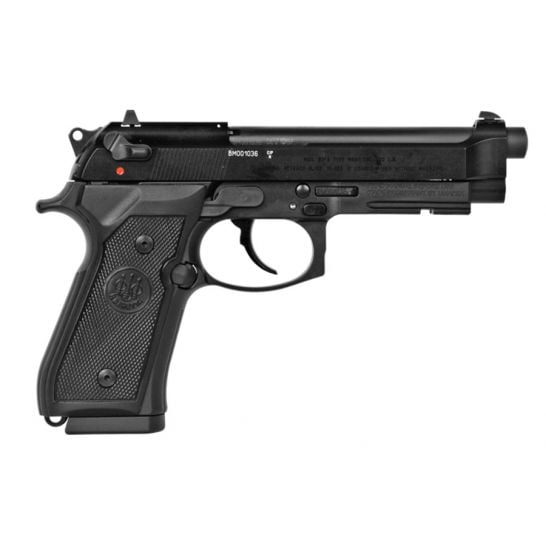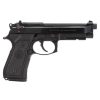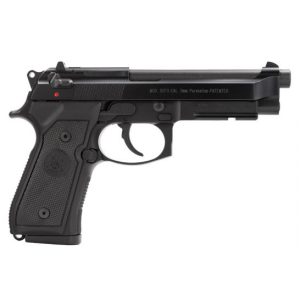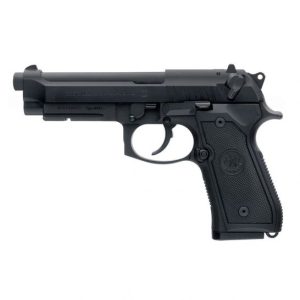Beretta M9A1 4.9" 15rd .22 LR Pistol, Black – J90A1M9A1F19 For Sale
$408.99
The Beretta M9A1 4.9″ 15rd .22 LR Pistol is a refined tactical firearm stemming from the battle-tested M9, incorporating feedback from military and law enforcement agencies worldwide to meet the US Marine Corps’ rigorous demands. It retains the legendary reliability of its predecessor while introducing enhancements for diverse peacekeeping missions, making it suitable for personal defense, home security, or concealed carry. Constructed with superior steel, it features a sand-resistant magazine with a PVD coating to prevent grit accumulation, ensuring performance in extreme conditions. Tactical enhancements include an integral Picatinny rail for attaching lights and lasers, a 3-dot sight system for rapid target acquisition, and a beveled magazine well for quick reloads. The M9A1 is notable for its low recoil, accuracy, and ability to handle various commercial ammunition types, establishing itself as a top-tier tactical pistol that meets the high standards of military, law enforcement, and discerning civilian users.
What is the difference between the Beretta M9 and the M9A1?
The main differences between the Beretta M9 and the M9A1 are related to design enhancements and features intended to improve performance and user experience:
1. **Accessory Rail**: The M9A1 features a Picatinny rail on the frame in front of the trigger guard, allowing for the attachment of tactical lights, lasers, and other accessories. The original M9 does not have this feature.
2. **Grip Design**: The M9A1 has an aggressively checkered front and back strap on the grip for improved handling and control, particularly when handling the pistol with wet or gloved hands. The M9 has a more traditional grip pattern.
3. **Reinforced Frame**: The M9A1 features a slightly redesigned frame with additional reinforcement intended for enhanced durability compared to the M9.
4. **Magazine Design**: The M9A1 typically comes with PVD-coated magazines. This coating is designed to reduce friction and corrosion, ensuring reliable feeding under various conditions, which can be advantageous over the standard magazines typically supplied with the M9.
5. **Beveled Magazine Well**: The M9A1 includes a beveled magazine well to facilitate quicker and easier reloading.
These enhancements are intended to cater to tactical users, such as military personnel or law enforcement, who might require more versatile and user-friendly features in a sidearm.
Which is better, M9A1 or 92A1?
Determining which is better between the M9A1 and the 92A1 largely depends on the specific needs and preferences of the user, as both are variations of the Beretta 92 series.
– **M9A1**: This model is an evolution of the original M9, which has been widely used by the U.S. military. It features a rail for mounting accessories like lights and lasers, enhanced grip design for better control, and an improved magazine design. It’s known for its durability and reliability under rigorous conditions.
– **92A1**: This model builds on the features of the M9A1 but offers additional improvements. It includes a recoil buffer to reduce wear and enhance shooting comfort, a removable front sight for customization, and a higher-capacity magazine (17 rounds compared to the M9A1’s 15). It’s designed for law enforcement and civilian use, offering a blend of military-grade performance and improved ergonomics.
If you prioritize military-grade specifications with a proven track record, the M9A1 might be the better choice. However, if you prefer more modern features and customization options, the 92A1 could be more suitable.
Is the Beretta M9 illegal?
The legality of the Beretta M9 depends on the specific laws and regulations of the country, state, or region you are in.
In the United States, the Beretta M9 is generally legal for civilian ownership, but certain states and local jurisdictions may have specific restrictions on handguns, magazine capacities, or features such as threaded barrels. Always check the local laws where you reside or plan to possess the firearm to ensure compliance with all legal requirements.
In other countries, the legality of owning or possessing a Beretta M9 can vary widely. Some countries may have strict gun control laws that prohibit private ownership of military-style firearms, while others may allow it with the proper licenses and permissions.
Always consult local laws and regulations or seek legal advice to understand the specific legal status of the Beretta M9 in your area.
What Beretta did the Navy SEALs use?
The Navy SEALs have used the Beretta M9 pistol in the past as their standard sidearm. However, they have transitioned to using the Sig Sauer P226, specifically the MK25 variant, for its durability and reliability in maritime environments.
What are the flaws of the Beretta M9?
The Beretta M9, widely used by the U.S. military, has faced several criticisms and noted flaws over the years. Some of these include:
1. **Size and Weight**: The M9 is relatively large and heavy for a 9mm pistol, which can make it cumbersome for personnel with smaller hands or those who need to carry it as a sidearm alongside other equipment.
2. **Ergonomics**: The grip may not be comfortable for all users, especially those with smaller hands, making it difficult for some to control the weapon effectively.
3. **Trigger Pull**: The double-action/single-action trigger system means that the first shot requires a heavy trigger pull, which can affect accuracy and precision in rapid response situations.
4. **Slide Failure**: Early models had issues with slide failures where the slide could potentially fracture and hit the operator. This was addressed in later models, but the reputation lingered for some time.
5. **Magazine Reliability**: Problems with the magazines, especially those produced by certain contractors, have been reported. These include issues like failure to feed, which can be critical during combat.
6. **Durability and Maintenance**: The M9 requires regular maintenance to function reliably, and some users reported that it can be more prone to wear and tear compared to other modern handguns.
7. **Stopping Power**: Critics argue that the 9mm round lacks the stopping power of larger calibers, although this is a more generalized debate about caliber effectiveness rather than a specific flaw of the M9.
8. **Sights**: The standard sights on the M9 have been described as not very user-friendly for rapid target acquisition in various lighting conditions.
These issues, among others, ultimately led to the U.S. military selecting the SIG Sauer P320 (designated as the M17/M18) to replace the M9 in 2017.
What Beretta did Mel Gibson use?
Mel Gibson used a Beretta 92FS pistol in the “Lethal Weapon” film series.
Is Beretta M9 better than 92FS?
The Beretta M9 and the Beretta 92FS are very similar firearms, with many shared features. The primary differences are mostly related to their intended uses and specific requirements:
1. **Designation & Use**:
– The M9 is the military designation for what is essentially the same pistol as the civilian 92FS. The M9 was adopted by the U.S. Armed Forces in 1985, while the 92FS is sold on the commercial market.
2. **Markings**:
– The M9 will have specific military markings and serial numbers. The 92FS typically features civilian markings.
3. **Rear Sight**:
– Some versions of the M9 come with a dot-and-post sight system, whereas the 92FS typically has three-dot sights.
4. **Safety Warnings**:
– The 92FS usually comes with a larger “read manual” warning inscription.
Ultimately, whether one is “better” than the other largely depends on personal preference and intended use. For collectors or military enthusiasts, the M9 might be more desirable due to its history and markings. For others, the distinctions might not significantly impact performance, as both models offer similar reliability and handling characteristics.
Will a Beretta 96A1 fit in a 92A1 holster?
Yes, the Beretta 96A1 will generally fit in a holster designed for the 92A1. Both models have similar dimensions, and holsters made for the 92A1 typically accommodate the 96A1 as well. However, it’s always a good idea to check with the holster manufacturer to confirm compatibility, as there may be slight variations or specific designs that could affect the fit.
What size mag does a Beretta M9A1 take?
The Beretta M9A1 uses a 15-round magazine for 9mm ammunition. However, magazines with larger capacities, such as 17 or 18 rounds, are also available for this model.
What pistol do Navy SEALs carry?
Navy SEALs typically carry the SIG Sauer P226 or the Glock 19 as their standard issue pistols.
Can a civilian buy an M9 Beretta?
Yes, a civilian can buy an M9 Beretta, as it is a semi-automatic pistol available for purchase by the general public in the United States, subject to federal, state, and local laws regarding firearm ownership. Buyers must comply with the regulations, including background checks and age restrictions, which vary by jurisdiction.
Why did the military stop using the Beretta M9?
The military decided to transition from the Beretta M9 to the SIG Sauer P320, designated as the M17 (full-size) and M18 (compact) in military service, primarily due to the Modular Handgun System program that aimed to improve modularity, ergonomics, adaptability, and overall effectiveness of the standard-issue sidearm. The P320’s modular design allows for better customization to fit different missions and hand sizes, easier maintenance, and improved performance. Furthermore, advancements in handgun technology and changing requirements over the years necessitated an update to the standard service pistol, leading to the military seeking options that offered newer features such as improved accuracy, better handling, and enhanced reliability and safety features.
What caliber is a Beretta m9a1?
The Beretta M9A1 is chambered in 9x19mm Parabellum (9mm).
What is the difference between the Beretta M9A3 and the M9A4?
The primary differences between the Beretta M9A3 and M9A4 include:
1. **Optics Readiness**: The M9A4 comes with an optics-ready slide, allowing for easy mounting of red dot sights, which is a feature not present on the M9A3.
2. **Grip Texture**: The M9A4 features more aggressive grip texturing, likely to enhance the user’s grip compared to the more traditional checkering on the M9A3.
3. **Color Option**: The M9A3 is typically available in a Flat Dark Earth (FDE) finish, while the M9A4 also has this finish but might have additional variations or more modernized options, depending on production at the time.
4. **Sight System**: The M9A4 is equipped with a tritium night sight system for better visibility in low-light conditions, which may differ from the M9A3’s standard sights.
These upgrades in the M9A4 reflect Beretta’s attempt to modernize and enhance the handgun’s tactical capabilities by incorporating features that cater to current demands for modularity and performance.
What is the difference between the M9 and the FS?
The primary difference between the Beretta M9 and the Beretta 92FS is in their intended use and some minor design elements. The M9 is a military version adopted by the U.S. armed forces, whereas the 92FS is the civilian version of the same handgun. Both pistols are 9mm semi-automatic handguns with similar dimensions and functionality.
Key differences include:
– The M9 often has a narrower slide design and military-specific markings or serial numbers.
– Some cosmetic and functional details may vary, such as the shape of the trigger guard and sights.
– Internally, both are similar, but the M9 may have additional parts designed to meet military standards.
Overall, the differences are subtle, with both models largely sharing the same fundamental design and performance characteristics.
| Model | M9A1 |
|---|---|
| Action | Double/Single |
| Overall Length | 8.5" |
| Sight Radius | 6.1" |
| Overall Width | 1.3" |
| Frame Size | Full Size |
Be the first to review “Beretta M9A1 4.9" 15rd .22 LR Pistol, Black – J90A1M9A1F19” Cancel reply
Related products
Beretta M9A1
Beretta M9A1




Reviews
There are no reviews yet.